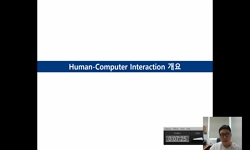Basic components for multimodal interface, such as speech recognition, speech synthesis, gesture recognition, and multimodal fusion, have their own technological limitations. For example, the accuracy of speech recognition decreases for large vocabula...
http://chineseinput.net/에서 pinyin(병음)방식으로 중국어를 변환할 수 있습니다.
변환된 중국어를 복사하여 사용하시면 됩니다.
- 中文 을 입력하시려면 zhongwen을 입력하시고 space를누르시면됩니다.
- 北京 을 입력하시려면 beijing을 입력하시고 space를 누르시면 됩니다.

음성기반 멀티모달 사용자 인터페이스의 사용성 평가 방법론 = Usability Test Guidelines for Speech-Oriented Multimodal User Interface
한글로보기https://www.riss.kr/link?id=A100900400
-
저자
홍기형 (성신여자대학교) ; Hong, Ki-Hyung
- 발행기관
- 학술지명
- 권호사항
-
발행연도
2008
-
작성언어
Korean
- 주제어
-
등재정보
KCI등재
-
자료형태
학술저널
-
수록면
103-120(18쪽)
-
KCI 피인용횟수
2
- 제공처
-
0
상세조회 -
0
다운로드
부가정보
다국어 초록 (Multilingual Abstract)
Basic components for multimodal interface, such as speech recognition, speech synthesis, gesture recognition, and multimodal fusion, have their own technological limitations. For example, the accuracy of speech recognition decreases for large vocabulary and in noisy environments. In spite of those technological limitations, there are lots of applications in which speech-oriented multimodal user interfaces are very helpful to users. However, in order to expand application areas for speech-oriented multimodal interfaces, we have to develop the interfaces focused on usability. In this paper, we introduce usability and user-centered design methodology in general. There has been much work for evaluating spoken dialogue systems. We give a summary for PARADISE (PARAdigm for Dialogue System Evaluation) and PROMISE (PROcedure for Multimodal Interactive System Evaluation) that are the generalized evaluation frameworks for voice and multimodal user interfaces. Then, we present usability components for speech-oriented multimodal user interfaces and usability testing guidelines that can be used in a user-centered multimodal interface design process.
참고문헌 (Reference)
1 홍기형, "음성기반 멀티모달 인터페이스 및 표준" 대한음성학회 0 (0): 117-136, 2004
2 박성수, "모바일 환경을 위한 멀티모달 미들웨어의 설계 및 구현" 대한음성학회 1 (1): 125-144, 2006
3 C.M.Barnum, "Usability Test and Research" Longman Publishers 2002
4 J.Nielsen, "Usability Engineering" Academic Press 1993
5 윤영식, "UI 설계-평가 프로세스 지원을 위한 인터랙션 설계시안의 사용성 예측 지표 개발" 353-358, 2006
6 김지영, "TV 가이드 영역에서의 음성기반 멀티모달 사용 유형 분석" 대한음성학회 1 (1): 101-117, 2006
7 N.Beringer, "PROMISE:A procedure for multimodal interactive system evaluation" 77-80, 2002
8 M.Walker, "PARADISE:A framework for evaluating spoken dialogue agents" 271-280, 1997
9 L.Dybkjaer, "Overview of evaluation and usability, Spoken Multimodal Human-Computer Dialogue in Mobile Environments" Springer 221-246, 2005
10 L. M. Reeves, "Guidelines for multimodal user interface design" 47 (47): 57-59, 2004
1 홍기형, "음성기반 멀티모달 인터페이스 및 표준" 대한음성학회 0 (0): 117-136, 2004
2 박성수, "모바일 환경을 위한 멀티모달 미들웨어의 설계 및 구현" 대한음성학회 1 (1): 125-144, 2006
3 C.M.Barnum, "Usability Test and Research" Longman Publishers 2002
4 J.Nielsen, "Usability Engineering" Academic Press 1993
5 윤영식, "UI 설계-평가 프로세스 지원을 위한 인터랙션 설계시안의 사용성 예측 지표 개발" 353-358, 2006
6 김지영, "TV 가이드 영역에서의 음성기반 멀티모달 사용 유형 분석" 대한음성학회 1 (1): 101-117, 2006
7 N.Beringer, "PROMISE:A procedure for multimodal interactive system evaluation" 77-80, 2002
8 M.Walker, "PARADISE:A framework for evaluating spoken dialogue agents" 271-280, 1997
9 L.Dybkjaer, "Overview of evaluation and usability, Spoken Multimodal Human-Computer Dialogue in Mobile Environments" Springer 221-246, 2005
10 L. M. Reeves, "Guidelines for multimodal user interface design" 47 (47): 57-59, 2004
11 W.Wahlster, "Dialogue systems go multimodal:The SmartKom experience, SmartKom: Foundations of Multimodal Dialogue Systems" Springer 3-27, 2006
동일학술지(권/호) 다른 논문
-
Stress Effects on Korean Vowels with Reference to Rhythm
- The Korean Society Of Phonetic Sciences And Speech Technology
- 윤일승
- 2008
- KCI등재
-
학령기 언어장애아동의 유추추론능력과 은유이해능력 간의 상관관계연구
- 대한음성학회
- 신후남
- 2008
- KCI등재
-
- 대한음성학회
- 황연시
- 2008
- KCI등재
-
- 대한음성학회
- 김태경
- 2008
- KCI등재
분석정보
인용정보 인용지수 설명보기
학술지 이력
| 연월일 | 이력구분 | 이력상세 | 등재구분 |
|---|---|---|---|
| 2009-01-01 | 평가 | 학술지 폐간(기타) | |
| 2007-01-24 | 학술지명변경 | 한글명 : 말소리</br>외국어명 : MALSORI |  |
| 2006-01-01 | 평가 | 등재학술지 선정(등재후보2차) |  |
| 2005-10-10 | 학술지명변경 | 한글명 : 말소리</br>외국어명 : MALSORI |  |
| 2005-05-30 | 학술지명변경 | 한글명 : 말소리</br>외국어명 : MALSORI |  |
| 2005-01-01 | 평가 | 등재후보 1차 PASS(등재후보1차) |  |
| 2003-01-01 | 평가 | 등재후보학술지 선정(신규평가) |  |




 ScienceON
ScienceON



